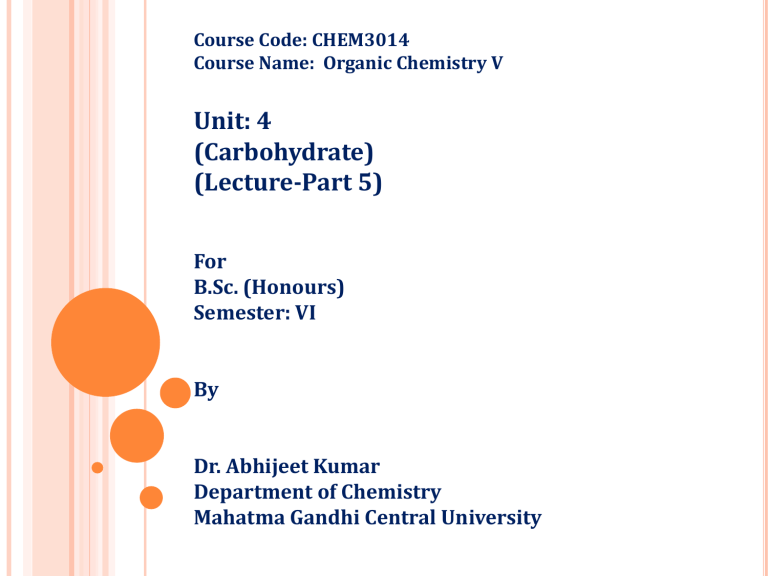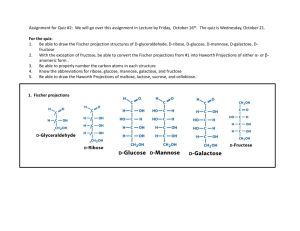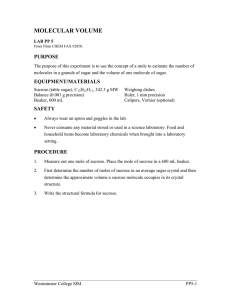
Course Code: CHEM3014 Course Name: Organic Chemistry V Unit: 4 (Carbohydrate) (Lecture-Part 5) For B.Sc. (Honours) Semester: VI By Dr. Abhijeet Kumar Department of Chemistry Mahatma Gandhi Central University Reactions of Monosaccharides Osazone Formation: The reaction between three moles of phenylhydrazine and one mole of aldose produces a crystalline product known as phenylosazone (Scheme 1). Phenylosazones crystallize readily (unlike sugars) and are useful derivatives for identifying sugars. Scheme 1: Phenyl osazone formation from aldose Osazone formation results in a loss of the chirality center at C2 but does not affect other chirality centers. Mechanism of Osazone Formation The reaction begins with the formation of phenyl hydrazone with one equivalent of phenylhydrazine . Upon treating the phenylhydrazones with two additional equivalents of phenylhydrazine, osazone formation occurs. one of the equivalents of phenylhydrazine is converted into aniline (PhNH2) and ammonia (NH3) (Scheme 2). Scheme 2: Proposed Mechanism for Phenyl osazone formation from aldose Although the mechanism of the phenylhydrazone formation in the first step is clear. But the next steps towards the formation of the osazone has been explained by various other mechanisms. Please refer to the study material provided below. BARRY, V., MITCHELL, P. Mechanism of Osazone Formation. Nature 175, 220 (1955). https://doi.org/10.1038/175220a0 Example of Osazone Formation Under mild conditions both D-glucose, D-mannose and D-Fructose form same osazone (Scheme 3). Scheme 3: Osazone formation from different aldoses Formation of identical osazone in case of both D-glucose and D-mannose indicates that both have the same configurations about C3, C4, and C5. Diastereomeric aldoses that differ in configuration at only one carbon (such as D-glucose and Dmannose) are called epimers. In general, any pair of diastereomers that differ in configuration at only a single tetrahedral chirality center can be called epimers. Synthesis and Degradation of Monosaccharides Kiliani–Fischer Synthesis: In order to increase the chain length, Heinrich Kiliani (Freiburg, Germany) suggested a method which involves transformation of an aldose to the epimeric aldonic acids having one additional carbon through the addition of hydrogen cyanide and subsequent hydrolysis of the epimeric cyanohydrins. Fischer later extended this method by showing that aldonolactones obtained from the aldonic acids can be reduced to aldoses. Therefore this method of transforming aldose to higher aldoses is known as Kiliani-Fisher synthesis. Addition of hydrogen cyanide to glyceraldehyde produces two epimeric cyanohydrins because the reaction creates a new chirality center. The cyanohydrins can be separated easily (since they are diastereomers), and each can be converted to an aldose through hydrolysis, acidification, lactonization, and reduction with Na–Hg at pH 3–5. One cyanohydrin ultimately yields D-(-)-erythrose and the other yields D-(-)-threose. (Please refer to next page/slide for the different steps involved in it (Scheme 4)) Different Steps in Kiliani–Fischer Synthesis Scheme 4: Different steps involved in Phenyl osazone formation from aldose Ruff Degradation Ruff degradation can be used to shorten the chain. Scheme 5: Different steps involved in Ruff degradation Ruff degradation involves (1) oxidation of the aldose to an aldonic acid using bromine water and (2) oxidative decarboxylation of the aldonic acid to the next lower aldose using hydrogen peroxide and ferric sulfate. For example, D-(-)-Ribose, for example, can be degraded to D-(-)erythrose (Scheme 5). Reducing Sugar Reducing sugar : Sugars that reduce Tollens’ or Benedict’s reagents. Benedict’s reagent (an alkaline solution containing a cupric citrate complex ion) and Tollens’ solution [Ag+(NH3)2OH-] oxidize and thus give positive tests with aldoses and ketoses. The tests are positive even though aldoses and ketoses exist primarily as cyclic hemiacetals. Benedict’s solution and the related Fehling’s solution (which contains a cupric tartrate complex ion) give brick red precipitates of Cu2O when they oxidize an aldose (Scheme 6) . In alkaline solution ketoses are converted to aldoses, which are then oxidized by the cupric complexes. Since the solutions of cupric tartrates and citrates are blue, the appearance of a brick-red precipitate is a vivid and unmistakable indication of a positive test. All sugars that contain hemiacetal or hemiketal groups (and therefore are in equilibrium with aldehydes or α-hydroxy-ketones) are reducing sugars. Reducing and Non-reducing Sugar In aqueous solution the hemiacetal form of sugars exists in equilibrium with relatively small, but not insignificant, concentrations of noncyclic aldehydes or a-hydroxy ketones. It is the latter two that undergo the oxidation, perturbing the equilibrium to produce more aldehyde or α-hydroxy ketone, which then undergoes oxidation until one reactant is exhausted. Scheme 6: Oxidation of aldose using Benedict’s solution. Non-reducing Sugar: Carbohydrates that contain only acetal groups do not give positive tests with Benedict’s or Tollens’ solutions, and they are called non reducing sugars. Identification of Reducing and Non-reducing Sugar Figure 1: Fundamental difference between reducing and non-reducing sugar Acetals do not exist in equilibrium with aldehydes or a-hydroxy ketones in the basic aqueous media of the test reagents. Question: How might you distinguish between α-D-glucopyranose (i.e., D-glucose) and methyl α-Dglucopyranoside? Disaccharides Sucrose: It is a disaccharide composed of glucose and fructose which are joined together with glycosidic linkage (Figure 2). Ordinary table sugar is a disaccharide called sucrose. Sucrose, the most widely occurring disaccharide, is found in all photosynthetic plants and is obtained commercially from sugarcane or sugar beets. . Figure 2: Structure of sucrose Determination of Structure of Sucrose The structure of sucrose is based on the following evidence: (a) Sucrose has the molecular formula C12H22O11. (b) Acid-catalyzed hydrolysis of 1 mol of sucrose yields 1 mol of D-glucose and 1 mol of Dfructose. (c) Sucrose is a non reducing sugar; it gives negative tests with Benedict’s and Tollens’ solutions. (d) Sucrose does not form an osazone and does not undergo mutarotation. These observations mean that neither the glucose nor the fructose portion of sucrose has a hemiacetal group. Thus, the two hexoses must have a glycosidic linkage that involves C1 of glucose and C2 of fructose, for only in this way will both carbonyl groups be present as full acetals (i.e., as glycosides). (e) The stereochemistry of the glycosidic linkages can be inferred from experiments done with enzymes. Sucrose is hydrolyzed by an α-glucosidase obtained from yeast but not by β-glucosidase enzymes. This hydrolysis indicates an α configuration at the glucoside portion. (f) Sucrose is also hydrolyzed by sucrase, an enzyme known to hydrolyze β-fructofuranosides but not α-fructofuranosides. This hydrolysis indicates a b configuration at the fructoside portion. (g) The structure of sucrose has been confirmed by X-ray analysis and by an unambiguous synthesis. Structure determination of Maltose The structure of maltose was deduced based on the following evidence: (a) When 1 mol of maltose is subjected to acid-catalyzed hydrolysis, it yields 2 mol of D-(+)glucose. (b) Unlike sucrose, maltose is a reducing sugar; it gives positive tests with Fehling’s, Benedict’s, and Tollens’ solutions. Maltose also reacts with phenylhydrazine to form a monophenylosazone (i.e., it incorporates two molecules of phenylhydrazine). (c) Maltose exists in two anomeric forms: α-(+)-maltose, [α]D25 = + 168, and β-(+)-maltose, [α]D 25 = + 112. The maltose anomers undergo mutarotation to yield an equilibrium mixture, [α]D 25 = +136. Figure 3: Structure of Maltose Assignment 1. Although D-fructose is not an epimer of D-glucose or D-mannose (D-fructose is a ketohexose), all three yield the same phenylosazone. (a) Using Fischer projection formulas, write an equation for the reaction of fructose with phenylhydrazine. (b) What information about the stereochemistry of D-fructose does this experiment yield? 2. (a) What are the structures of L-(+)-threose and L-(+)-erythrose? (b) What aldotriose would you use to prepare them in a Kiliani–Fischer synthesis? 3. (a) Outline a Kiliani–Fischer synthesis of epimeric aldopentoses starting with D-(-)-erythrose (use Fischer projections). (b) The two epimeric aldopentoses that one obtains are D(-)-arabinose and D-(-)-ribose. Nitric acid oxidation of D-(-)-ribose yields an optically inactive aldaric acid, whereas similar oxidation of D-(-)-arabinose yields an optically active product. On the basis of this information alone, which Fischer projection represents D-(-)arabinose and which represents D-(-)-ribose? 4. Subjecting D-(-)-threose to a Kiliani–Fischer synthesis yields two other epimeric aldopentoses, D(+)-xylose and D-(-)-lyxose. D-(+)-Xylose can be oxidized (with nitric acid) to an optically inactive aldaric acid, while similar oxidation of D-(-)-lyxose gives an optically active product. What are the structures of D-(+)-xylose and D-(-)-lyxose? References Information regarding source of study materials: 1. Chapter 22, Organic Chemistry (10th edition); Publisher: John Wiley & Sons, Inc. Authors: T. W. G. Solomons and C. B. Fryhle. 2. Chapter 16, ‘Organic Chemistry’; Publisher: Oxford University Press; 2nd edition; Authors: Jonathan Clayden , Nick Greeves , Stuart Warren. Rest of the topics of this unit will be discussed in next part of the lecture. Stay Happy, Healthy and Safe!


